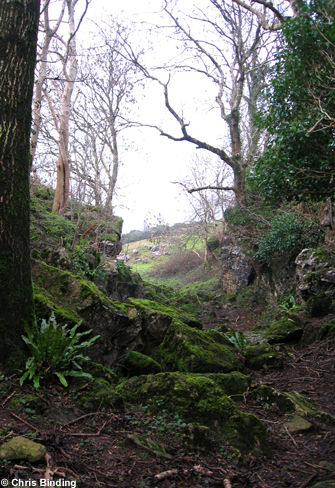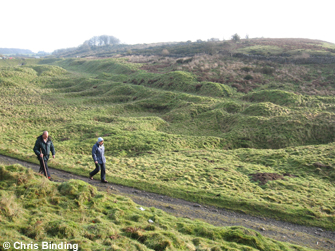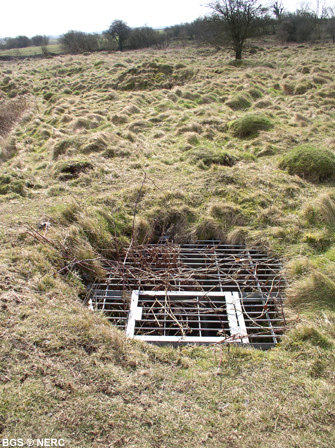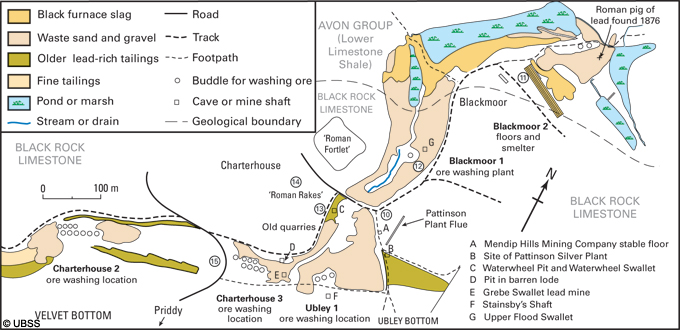
Industrial archaeology — mine workings


The remains of mine workings can be seen across much of central and western Mendip, especially around Shipham, Charterhouse, Priddy and Stockhill Forest. Iron, lead, zinc and ochre have all been mined at various times and places across Mendip. The old mine workings are often characterised by areas of 'gruffy' ground, a local name for uneven hummocky landscape created during mining operations. On eastern Mendip, coal mining was more important.
The ore was dug out from mineral veins known as rakes, which can be seen as lines of pits and spoil heaps or small rocky ravines around Charterhouse, Stockhill Forest, Lamb Leer and Shipham, although many have now been infilled. Locally deeper shafts were sunk to try and exploit the ore at depth. Around some of these shafts are flat circular areas of ground marking the position of the horse driven gin (or winch) used to wind the ore up to the surface.
Once the ore was brought to the surface, it had to be processed before being smelted. First it was washed and concentrated in circular pits known as buddles. These small stone-lined convex circular pits once contained rotating brushes which enabled the ore to be concentrated by washing the lighter impurities off with water and leaving the heavy lead ore behind.
Because of the demand for water, the buddles had to be near a reliable water supply, which is why the ore processing plants were located at Charterhouse, Smitham Hill and the area around Stockhill Forest. Here the local geology permits surface drainage. The miners dammed up these streams and fed the water via leats or culverts to the washing sites. The concentrated ore was taken to be smelted while the waste material (known as gangue) such as calcite ended up on the spoil tip. The waste water was diverted into the nearest convenient swallet hole.

Once the ore was washed and processed, it was smelted, either on site or elsewhere. However, early smelting techniques were primitive and much lead was left behind in the slag. In the 18th century, much better technology was used to re-smelt the old lead rich waste. This they did using a stream-driven fan which forced hot air over the slag. The vapourised lead condensed in a series of long horizontal stone flues where it was removed by hand, a particularly unpleasant and dangerous job! The remains of the flues, and the accompanying black glassy slag heaps can be seen at Charterhouse, Priddy and on Smitham Hill, where the last remaining chimney still stands.
Today, the landscape still bears the scars of mining, but the old mine workings are now important nature reserves and are of special historic and scientific interest.
- Home
- Overview maps
- Locality
areas
- Cheddar Gorge
- Charterhouse
- Blackdown
- Burrington Combe
- Shipham & Rowberrow
- Crook Peak & Axbridge
- Banwell to Churchill
- Priddy
- Harptree & Smitham Hill
- Draycott & Westbury-sub-Mendip
- Wookey Hole & Ebbor Gorge
- Wells
- Great Elm & Vallis Vale
- Mells & the Wadbury Valley
- The Vobster area
- The Whatley area
- Torr Works & Asham Wood
- Beacon Hill
- Stoke St Michael & Oakhill
- Holwell & Nunney
- Shepton Mallet & Maesbury
- Gurney Slade & Emborough
- The Nettlebridge valley
- Geology
- Minerals and mines
- Quarrying
- Caves and karst
- Biodiversity
- Detailed site information
- Acknowledgements
- External links
- Search
- Site map
